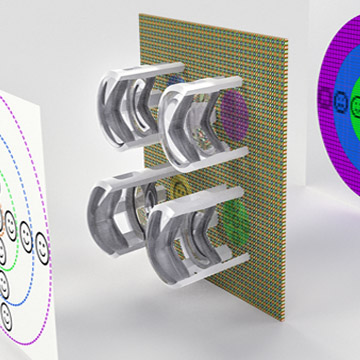
A visual depiction of the working principle of foveated imaging: Four lenses with different focal lengths image the object. The information is later combined digitally. [Image: University of Stuttgart]
To spot their prey from huge distances, raptors have developed such sharp vision that “eagle-eyed” has become a common description of high visual acuity. Now, inspired by the birds’ legendary foveal vision, researchers at a German university have printed multiple doublet lenses onto an image sensor to create a miniaturized high-resolution camera (Sci. Advances, doi:10.1126/sciadv.1602655).
Both raptors and humans have sharp central vision where the eyes’ adjustable optical structures focus light best. However, the tiny camera created by the University of Stuttgart team digitally combines images from four fixed doublets, with four different focal lengths.
On the wings of CMOS
Using commercial ray-tracing software, the researchers designed four air-spaced doublets with fields of view ranging from 20 to 70 degrees, and different focal lengths (from wide angle to short telephoto on a traditional camera). A 3-D printer built the transparent-lens structures on top of a glass substrate (needed for characterization tests), and a complementary metal-oxide-semiconductor (CMOS) sensor.
One of the biggest challenges of this proof-of-concept project was, according to lead author Simon Thiele, printing the lenses correctly onto the CMOS chip. “Since some layers of the chip were heating up when the focused light of the 3-D printer hit them, the liquid material which is usually hardened by the light was locally evaporating and the bubbles destroyed the results,” he says. “We, therefore, had to carefully optimize the optical power to find a trade-off between low heat development and optimum polymerization.”
It's a bird, it's a camera
None of the printed doublets is taller than 200 μm, and the 2 x 2 lens array is shorter than 300 μm on a side—roughly two orders of magnitude smaller than the eye of a typical bird of prey.
According to the Stuttgart team, it still takes an hour or two to fabricate each objective lens. Thus, the technique isn’t ready for high-volume manufacturing. Still, such tiny lenses may find uses in applications requiring quality over quantity, from medical endoscopes to surveillance drones. Thiele says he and his colleagues are working on a demonstration camera that could be attached to a small object, like a tennis ball.
